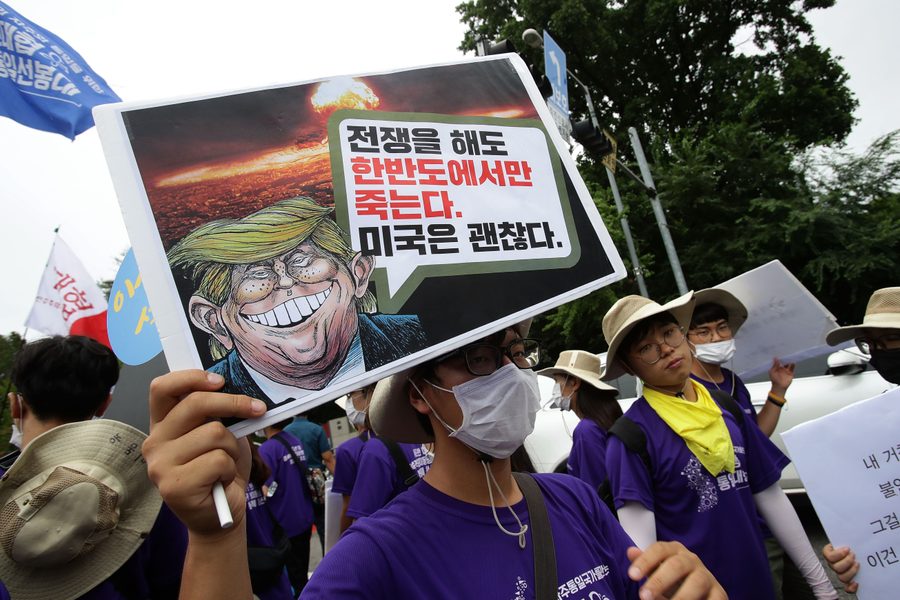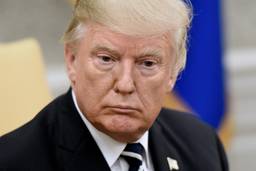Trump’s Visit Shows the U.S. Calls the Shots in South Korea. But Its People Intend To Resist.
It is up to the peace movement to rein in Trump on North Korea.
Christine Ahn

“Our goal is not war,” U.S. Secretary of Defense James Mattis conveyed across the Korean De-Militarized Zone (DMZ) ahead of President Trump’s visit to Asia. That was a wise statement, given that a U.S. war with North Korea would cause up to 300,000 civilian casualties in the first few days, according to a recent Congressional Research Service (CRS) report. And were nuclear weapons to be used, the CRS estimates 25 million people would be impacted.
As if that weren’t ominous enough, while President Donald Trump flew to Japan, the Pentagon sent a letter to Congressman Ted Lieu clarifying that a war with North Korea would involve a ground invasion in order to locate and secure North Korea’s nuclear reactors hidden and buried deep throughout the country. This was a clear signal to Trump from the U.S. military: A war with North Korea would be devastating and risk embroiling the entire region in World War III, as Republican Sen. Bob Corker has warned.
It’s clear that many throughout the U.S. government and military are trying to mitigate the President’s recklessness as he travels to South Korea, where thousands will welcome him with protests.
Another smart move was to prevent Trump from peering across the De-Militarized Zone (DMZ), as is customary for visiting U.S. presidents. The White House downplayed this decision, explaining that the DMZ has become “cliché,” and instead Trump would visit Camp Humphreys, which “would make more sense in terms of the president’s message.”
I’ve stood on both sides of the DMZ. In 2015, I crossed the DMZ, among the most fortified borders in the world, with 30 women peacemakers, and there is nothing banal about it. With 1.2 million landmines strewn across the 2.5-mile-wide tract of land that extends from the west to east coast of the Korean Peninsula, armed North and South Korean soldiers stand ready for war at a moment’s notice. The barbed-wire fencing lining the DMZ is the barrier separating millions of Korean families — and the site of Korea’s division by Cold War powers. Gloria Steinem, who crossed the DMZ with me, says, “There is no other strip of land more symbolic of long-term division.”
Yet, I couldn’t agree more with the White House that Trump’s visit to the U.S. Army Garrison Camp Humphreys in Pyongtaek, 40 miles south of Seoul, is more fitting.
More than a decade ago, I stood on the fertile land that Korean rice farmers tilled for generations, which has since become part of the Camp Humphreys U.S. Army base. I had traveled to join in solidarity with the residents of Daechuri and Doduri, who had waged a fierce resistance to the expansion of the U.S. military base. According to investigative journalist Jon Letman, the expansion of Camp Humphreys was part of a major realignment and consolidation of U.S. bases, which involved “moving tens of thousands of troops, their families and civilian contractors to U.S. Army Garrison Humphreys.”
The United States Forces Korea, which still maintains nearly 30,000 U.S. troops in South Korea, had announced in 2002 that it would triple Camp Humphreys from around 1,000 acres to more than 3,400 acres, making it the largest foreign military base in the world. Ironically, the expansion of the base in Pyongtaek took place during the height of South Korea’s Sunshine Policy with the North. Washington saw its role on the Korean Peninsula shift from primarily focusing on defending South Korea to using bases there for training and forward deployment to other conflicts.
Trump’s visit to Pyongtaek is an opportunity to shine a light on the unequal relationship between Washington and Seoul. It is also an opportunity to expose the Moon Jae-in administration’s failure to reject Trump’s hardline stance towards North Korea, even at the cost of South Korea’s own security.
Visiting Pyongtaek was a defining moment in my understanding of the ongoing costs of the unresolved Korean War. I still vividly recall greeting the villagers with a delegation of U.S. peace activists, including Medea Benjamin and Cindy Sheehan. In the dark of night, we had crossed two military checkpoints to finally reach the villagers in a barn they had transformed into a meeting place where they held their candlelight vigils and reminded themselves nightly why they were resisting. The Roh Moo Hyun administration wanted to suppress international attention to the resistance against the U.S. base expansion, but we managed to get in.
As I looked across at the villagers’ browned and weathered faces, I apologized to them in my broken Korean that their homes, the food they grew to feed their families and their ancient community was being destroyed in the name of my government’s national security. Korean grandmothers, in their seventies and eighties, had tied themselves to the roofs of their homes to prevent bulldozers from demolishing them. They gathered nightly in this barn which was decorated with artwork their grandchildren drew of their school and community center which became piles of rubble.
After waging a valiant, non-violent campaign for more than five years, they lost. So did the villagers of Gangjeong on Jeju Island, off the coast of the Korean Peninsula, who fought for years to block the construction of a naval base which now docks Aegis destroyer ships connected to the U.S. missile defense system.
Residents of Seongju, a city 135 miles south of Seoul, just lost an intense battle to prevent the installation of the U.S. Terminal High Altitude Area Defense (THAAD) missile defense system, which the Trump administration forced through during the political vacuum before the election of the liberal President Moon. Although most Seongju residents have historically voted along conservative lines, they now hold up signs saying, “Hey U.S. — are you friends or occupation troops?”
Seongju residents see themselves caught in the crossfire between North and South Korea — and between the United States and China. “The deployment of THAAD will increase tensions between South and North Korea and make the unification of Korea more difficult,” Ham Soo-yeon, a resident of Seongju, told In These Times.
Given that more than 75 percent of South Koreans think Trump is dangerous, according to a recent Pew survey, the U.S. president’s visit to Pyongtaek is a sobering reminder of Seoul’s client relationship with Washington, including not having wartime operational control over its own military. Eighty percent of South Koreans want inter-Korean reconciliation, but President Moon can’t improve inter-Korean relations by blindly following Washington’s maximum pressure, ranging from aggressive military drills rehearsing decapitation strikes to further isolating Pyongyang with even more sanctions. Moon has an overwhelming mandate from the candlelight revolution that rejected his predecessor’s hawkish policies towards North Korea and swept him into power.
There are some signs that Moon is beginning to push back against the United States. Seoul recently thawed relations with Beijing, which had chilled over the U.S. THAAD deployment, by refusing additional launchers from the United States. Moon also informed Mattis that South Korea wants the return of wartime operational control from Washington. In a speech last week, Moon affirmed that military action against North Korea “shall not be taken” without Seoul’s consent.
Trump’s visit raises questions about the soul of South Korea. Will Seoul be a willing servant to U.S. designs to further alienate its northern half, or pursue an independent policy towards reconciliation? This remains yet to be seen.
In the meantime, until President Moon is willing to press ahead with a new policy, including his earlier promise to sign a Peace Treaty to formally end the Korean War, it’s up to the anti-war and peace movements to rein in Trump’s war on Korea. Today, hundreds of major U.S., South Korean and Japanese civil society organizations released a joint statement calling upon their governments to avert war with North Korea through policies that could lead to regional peace. Following an online teach-in Women Cross DMZ conducted on October 25 with leading peace activists from Japan and South Korea, I was among a handful of peace activists who wrote the statement ahead of Trump’s visit to Asia.
The struggle to end the Korean War is about averting a potentially devastating conflict that would imperil millions of lives and engulf the region into a nuclear war. It’s about allowing the North and South Korean governments and people to overcome divisions, peacefully co-exist and eventually reunify. At stake are fundamental questions about how we define security in this ever-terrifying era of climate-change-induced natural disasters, including massive flooding and fires.
This struggle for humanity, for the ecological health of our planet, and the preservation of the things that give our lives meaning is embodied in the words of the village leader from Pyongtaek, Mr. Kim Ji-Tae. During the height of the villager’s resistance, when asked by the South Korean Ministry of Defense how much he would be willing to sell his land for the U.S. base expansion, Kim replied, “The price must include every grain of rice grown and harvested here. It must include all of our efforts to grow them, as well as our whole life here, including our sighs, tears and laughter. The price must include the stars, which have witnessed our grief and joy, and the wind, which has dried our tears.”





